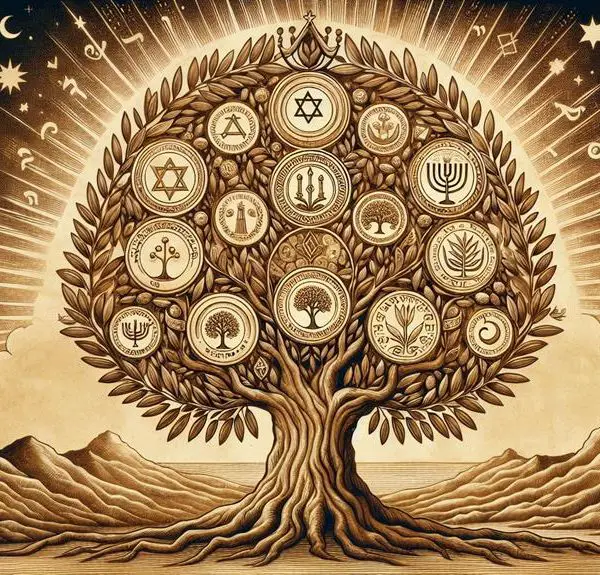Learn how the biblical wilderness goes beyond mere desolation, embodying transformation and divine mysteries that beckon deeper exploration.

Wilderness Definition in the Bible
You've likely heard that the wilderness plays a pivotal role in the Bible, but have you ever stopped to consider its true definition and significance?
This barren land isn't just a backdrop for trials and temptations; it's a complex symbol with layers of meaning that vary across different narratives. From Moses' 40 years to Jesus' 40 days, the wilderness serves as a place of transformation and divine encounter.
But there's more to its story and relevance than meets the eye, leaving one to wonder how these ancient lessons apply to our modern lives.
Let's explore this terrain together, uncovering insights that might just reshape your understanding of the biblical wilderness.
Key Takeaways
- Wilderness in the Bible symbolizes a place of spiritual testing and transformation.
- It serves as a setting for divine encounters and personal renewal.
- Biblical narratives associate wilderness with lessons of resilience, faith, and growth.
- Represents a journey towards spiritual maturity and deeper communion with God.
Biblical Wilderness: An Overview

In exploring the biblical wilderness, one encounters a multifaceted symbol that profoundly shapes the narratives and teachings of Scripture. This landscape isn't merely a backdrop; it's a character in its own right, teeming with desert flora and testing the resilience of those who traverse its expanse. You'll find that the wilderness locations mentioned in the Bible aren't uniform; they vary greatly, each offering a unique set of challenges and encounters.
The desert flora, often overlooked, plays a crucial role in these narratives. It's not just about the scarcity of food and water but also about the profound lessons learned in the midst of adversity. Plants like the acacia, capable of thriving in arid conditions, or the broom tree, under which Elijah found shade and respite, are more than mere details. They're symbols of life and sustenance in an environment that constantly tests the limits of survival.
Wilderness locations in the Bible, such as Sinai, Zin, or Kadesh-Barnea, aren't just geographical markers. They're stages on which the drama of faith, doubt, provision, and punishment unfolds. Each location carries with it a narrative of encounter – with God, with oneself, and with the community. These aren't just journeys through physical landscapes but through spiritual and moral testing grounds.
Understanding the biblical wilderness requires you to delve into the intricacies of these locations and the desert flora that populates them. It's a journey that reveals the complexity of human faith, the challenges of divine provision, and the profound transformations that can occur in the most barren of places.
Symbolism and Significance
Exploring the wilderness in the Bible reveals a rich tapestry of symbolism and significance, deeply intertwined with the human experience of faith and survival. The desert landscapes aren't just physical locations but embody layers of metaphorical meaning that resonate with spiritual journeys and trials.
The wilderness, with its harsh, unyielding terrain, serves as a powerful backdrop against which the themes of temptation, purification, and transformation unfold. It's in these barren spaces that one encounters the profound paradox of spiritual solitude: isolation that leads not to despair but to a deeper communion with the divine. This solitude strips away distractions, compelling a confrontation with one's innermost fears, desires, and ultimately, one's profound need for God.
To better understand the multifaceted symbolism of the wilderness in biblical texts, consider:
- Desert metaphors as reflections of spiritual desolation: The desert often symbolizes a state of spiritual barrenness, a place where faith is tested and refined. It's a space where the faithful are stripped of worldly comforts, compelling them to rely wholly on God's provision and guidance.
- Spiritual solitude as a means of divine encounter: In the silence and isolation of the wilderness, individuals are drawn into closer intimacy with God. This solitude isn't abandonment but an invitation to deeper spiritual engagement and revelation.
- The wilderness as a site of transformation: The journey through the wilderness is emblematic of the believer's journey towards spiritual maturity. It's here that one's character is forged, faith is deepened, and a new identity in relation to God is formed.
The biblical wilderness, then, is far more than a mere geographic locale. It's a dynamic symbol of life's spiritual pilgrimages, echoing the profound truths about human vulnerability, divine faithfulness, and the transformative power of encountering God in the most unexpected places.
Key Figures and Narratives

Several key figures and narratives in the Bible exemplify the profound spiritual transformations that occur within the wilderness, highlighting its role as both a physical and metaphorical space of testing and growth. Moses' exile and Elijah's journey are particularly illustrative of this dynamic, offering rich insights into the wilderness experience as a crucible for spiritual development.
Moses' exile to Midian, after fleeing Egypt, is a period of intense personal transformation. In the solitude of the wilderness, Moses encounters God in the burning bush, a pivotal moment that not only defines his prophetic mission but also illustrates the wilderness as a space where divine revelation occurs away from the distractions of society. This encounter not only prepares Moses for the challenges ahead but also signifies the wilderness as a place of calling and purification.
Similarly, Elijah's journey into the wilderness, fleeing from Jezebel's threat, underscores the wilderness as a realm of divine encounter and personal renewal. It's here that Elijah experiences God's presence not in the earthquake or fire, but in a gentle whisper, emphasizing the wilderness as a space where the divine communicates in unexpected ways, fostering deep spiritual insight and resilience.
These narratives underscore the wilderness not just as a physical location but as a transformative space where isolation becomes a conduit for profound spiritual encounters and growth. Through Moses' exile and Elijah's journey, the Bible illustrates how the wilderness serves as a backdrop for moments of profound personal and spiritual development, reinforcing its significance as a metaphorical space of testing, revelation, and renewal.
Lessons From the Desert
Venturing into the desert, biblical narratives teach us invaluable lessons about resilience, faith, and personal growth amid adversity. These stories, rich in metaphor and meaning, offer deep insights into the human condition, challenging you to explore the realms of desert survival and spiritual isolation. The desert, often harsh and unforgiving, becomes a crucible for transformation.
Here are three key lessons you can glean from these narratives:
- Resilience in the Face of Scarcity: Desert survival isn't just about finding water or shelter but about the resilience of spirit. The biblical wilderness teaches that in the most barren places, faith can sustain you, providing 'water' in the driest of deserts. This lesson speaks to the heart's capacity to find hope and strength when resources seem nonexistent.
- Spiritual Isolation as a Path to Enlightenment: The desert is a place of spiritual isolation, stripping away distractions and forcing introspection. It's in this isolation that one can truly listen to the divine, learning lessons of humility, patience, and trust. The biblical wilderness narratives underscore the importance of solitude in spiritual growth, suggesting that true enlightenment often comes only after a period of separation and reflection.
- Personal Growth Through Adversity: The desert's hardships aren't punishments but opportunities for personal development. These narratives illustrate how trials can shape character, refine beliefs, and strengthen resolve. The journey through the desert becomes a metaphor for life's challenges, teaching that growth often requires traversing difficult landscapes.
In analyzing these lessons, it's clear that the biblical wilderness isn't just a physical locale but a profound symbol of life's trials and the growth they can engender.
Modern Interpretations and Relevance

Having examined the timeless lessons from biblical wilderness narratives, we now turn our attention to their modern interpretations and relevance, uncovering how ancient wisdom continues to illuminate contemporary life. You're living in an era where the principles extracted from these narratives aren't just historical curiosities but are applied in innovative ways to address today's challenges.
Consider environmental stewardship, a concept deeply rooted in the stewardship of the Earth as depicted in the Bible. The wilderness stories encourage a respectful, sustainable relationship with nature, reminding you of the responsibility to protect and preserve the environment for future generations. This perspective is crucial in today's world, where environmental concerns are more pressing than ever.
Spiritual retreats represent another contemporary application of biblical wilderness. These retreats offer you a chance to disconnect from the hustle and bustle of daily life, akin to the biblical figures who found clarity and divine guidance in the solitude of the wilderness. It's an opportunity to reflect, renew faith, and gain perspective, highlighting the enduring importance of finding one's own 'wilderness' for personal growth and spiritual deepening.
Aspect |
Biblical Basis |
Modern Relevance |
|---|---|---|
Environmental Care |
Dominion and stewardship over nature |
Sustainable living and conservation |
Spiritual Renewal |
Solitude for reflection and guidance |
Spiritual retreats and mindfulness |
Personal Transformation |
Trials leading to growth |
Challenges as opportunities for growth |
These parallels between ancient scripture and contemporary practice show that the lessons from the wilderness are not bound by time. They continue to offer guidance, inspire actions towards environmental stewardship, and provide a blueprint for meaningful spiritual retreats and personal transformation.
Frequently Asked Questions
How Does the Concept of Wilderness in the Bible Compare to Other Ancient Cultures' Views on Wilderness?
You're delving into how ancient cultures viewed wilderness compared to the biblical perspective. Noticeably, while the Bible often sees wilderness as a place of trial and divine encounter, other cultures might've seen it as mere untamed land, awaiting urban development.
This divergence isn't just geographical but deeply rooted in cultural metaphors. Your exploration reveals a rich tapestry of beliefs where wilderness serves as a backdrop for understanding humanity's place within the natural and spiritual worlds.
Are There Specific Hebrew or Greek Words Translated as "Wilderness" in the Bible, and Do They Carry Different Nuances?
Yes, in the Bible, specific Hebrew and Greek words are translated as 'wilderness,' each carrying unique nuances. You'll find desert symbolism and wilderness metaphors richly embedded in these terms, reflecting both physical landscapes and spiritual journeys.
Analyzing these words reveals deeper insights into biblical narratives, where wilderness isn't just a deserted place but a context for transformation and divine encounters. This scholarly approach uncovers the layers of meaning behind the biblical concept of wilderness.
How Has the Ecological Understanding of the Areas Described as Wilderness in the Bible Changed With Modern Environmental Studies?
Your understanding of biblical 'wilderness' areas has evolved significantly due to modern environmental studies. These areas, once thought to be barren, are now recognized for their desert biodiversity and intricate ecosystems. Climate adaptation strategies highlight the resilience and complexity of these habitats.
This shift in perception underscores a deeper appreciation for the ecological nuances, challenging traditional views and encouraging a more holistic interpretation of these ancient landscapes.
Were There Any Specific Rituals or Religious Practices Performed Exclusively in Wilderness Settings According to Biblical Texts?
Yes, the biblical texts weave tales of Desert Miracles and Wilderness Wanderings, where the stark, untamed landscapes serve as backdrops for unique religious practices.
You'll find that in these barren expanses, prophets sought solitude, receiving divine revelations, and entire communities engaged in ritualistic practices, signifying purification and preparation.
These narratives aren't just historical accounts; they're deeply symbolic, illustrating both physical and spiritual journeys through life's desolate stretches.
Can the Biblical Notion of Wilderness Be Reconciled With Contemporary Efforts to Conserve Natural Landscapes?
You can indeed reconcile the biblical notion of wilderness with contemporary efforts to conserve natural landscapes.
By analyzing both concepts, it's clear that wilderness preservation aligns with stewardship values found in biblical texts.
Despite the push towards urban development, these efforts emphasize the importance of maintaining natural spaces.
This approach not only respects historical and religious contexts but also addresses modern environmental concerns, highlighting a shared commitment to protecting our planet's wilderness areas.
Conclusion
In conclusion, the biblical wilderness isn't just a physical locale but a profound symbol interwoven with themes of trial, transformation, and divine encounter.
Consider Moses in the desert: his journey not only reshaped his identity but also underscored the wilderness as a crucible for spiritual revelation and growth.
This ancient narrative continues to resonate today, urging us to find meaning in our own wilderness experiences—be they literal or metaphorical—highlighting the timeless relevance of these biblical lessons in our modern quest for purpose and understanding.



Sign up